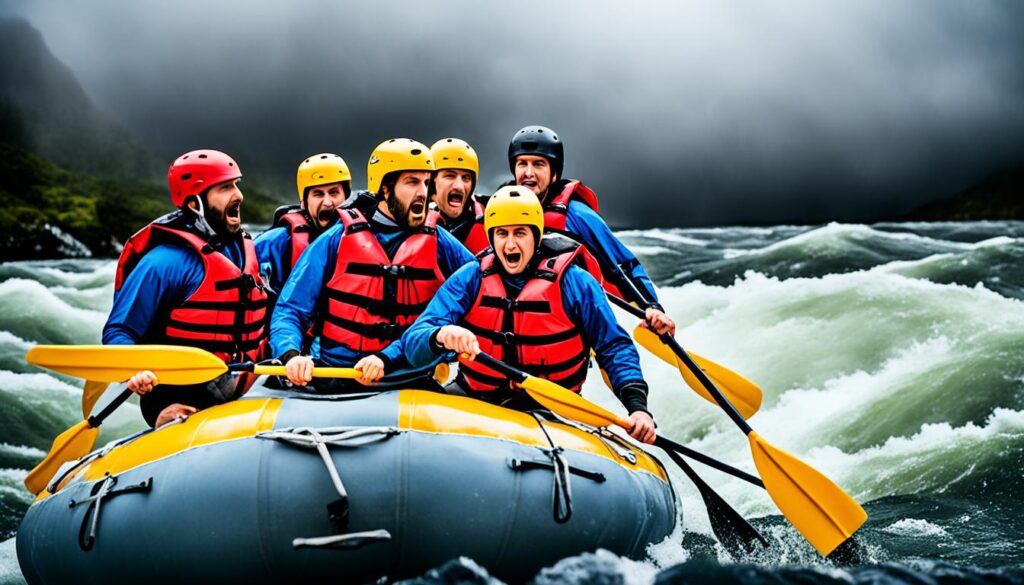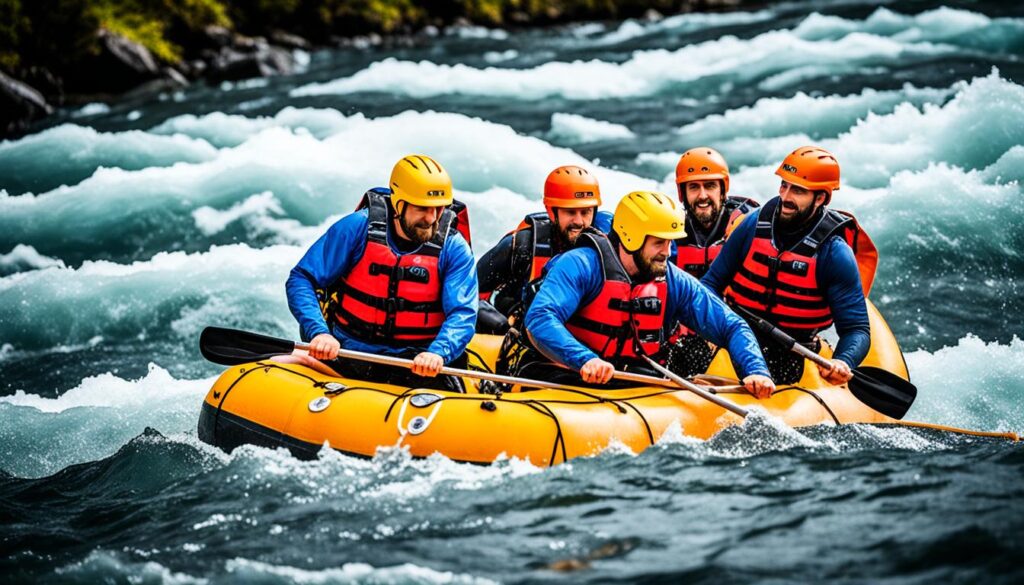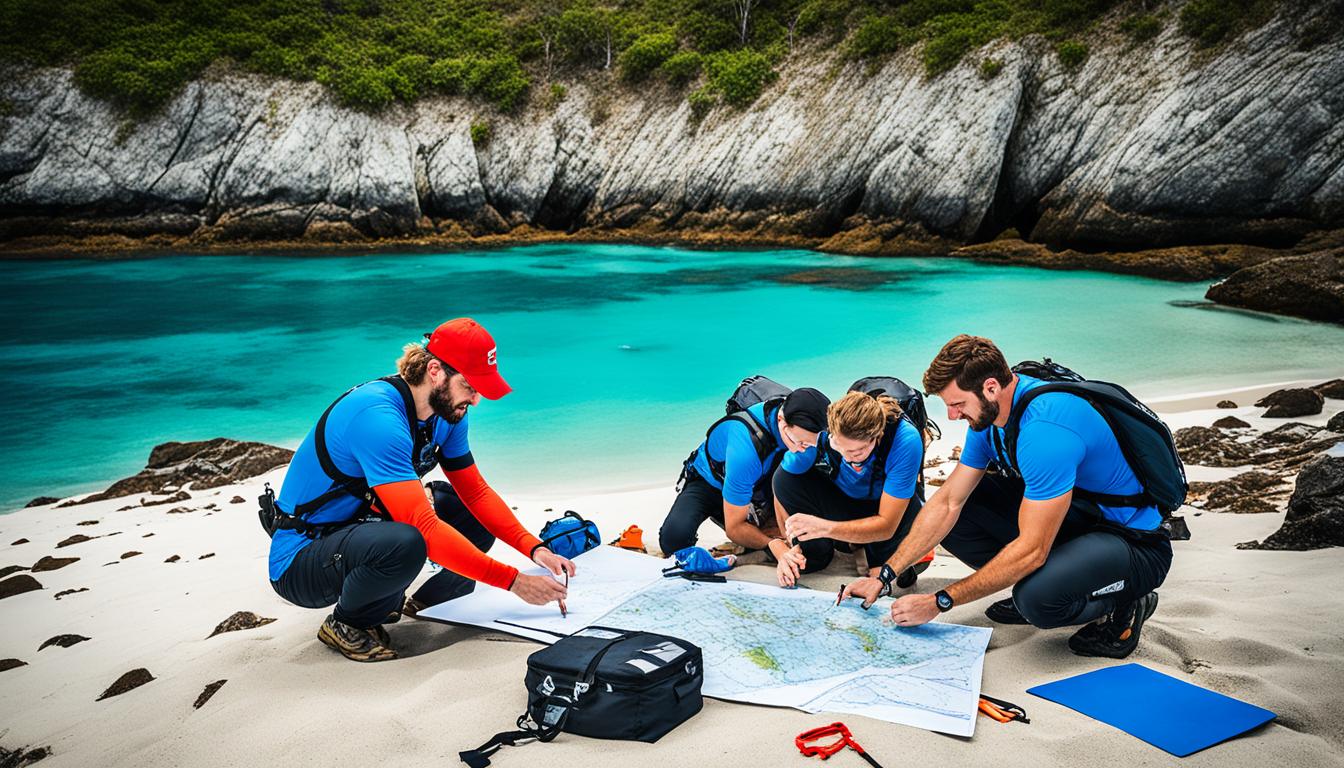Imagine being stranded at sea after a yacht accident, with nothing but the vast ocean stretching out in all directions. As panic sets in, you realize that your survival depends on the ability of your team to work together, make critical decisions, and collaborate effectively.
This harrowing scenario is the basis of the Lost at Sea team dynamics exercise. It is a powerful tabletop activity that aims to improve team dynamics, enhance problem-solving skills, and foster group collaboration. This exercise provides an immersive experience that challenges individuals to navigate the complexities of teamwork in a high-pressure situation.
Picture it: the sun beating down, the sound of crashing waves, and the weight of responsibility resting on your shoulders. With time running out, you and your team must rank a set of items in order of importance for survival. This exercise not only tests your ability to think critically but also highlights the significance of effective communication, shared decision-making, and strong leadership.
By participating in the Lost at Sea team dynamics exercise, you and your team will gain valuable insights into your strengths and weaknesses as a group. You will learn how to overcome obstacles, adapt to challenging circumstances, and develop the essential skills needed for successful teamwork.
Are you ready to embark on this thrilling and educational journey? Let’s dive in and discover how this exercise can transform your team dynamics and elevate your collaborative abilities.
Key Takeaways:
- The Lost at Sea team dynamics exercise is a tabletop scenario that simulates a survival situation at sea.
- It challenges teams to collaborate, communicate effectively, and make critical decisions under time constraints.
- This exercise promotes teamwork, problem-solving skills, and leadership development.
- Debriefing and reflection after the exercise allow participants to gain deeper insights into team dynamics and personal growth.
- By incorporating the Lost at Sea exercise into team building activities, organizations can enhance team cohesion and performance.
Purpose and Description of the Exercise
The Lost at Sea team dynamics exercise is designed to enhance teamwork and collaboration by placing participants in a time-constrained environment where they must work together to accomplish a project. This exercise aims to develop crucial teamwork skills such as problem-solving, effective communication, and critical thinking. It also exposes individuals to the importance of going beyond the crowd, making informed decisions, and experiencing the consequences of their choices. By simulating a scenario where a team is lost at sea, participants are challenged to rank a set of items in order of importance for survival. Through teamwork, the exercise encourages exploration of different perspectives and the application of critical thinking skills.
During the Lost at Sea team dynamics exercise, participants must navigate the challenges of effective team communication and coordination. By simulating a survival scenario, the exercise promotes collaboration and emphasizes the need for clear and efficient communication in problem-solving. Participants are encouraged to share their thoughts and ideas openly, fostering an environment that values diverse perspectives and promotes effective collaboration. Through this exercise, individuals can gain valuable insights into the dynamics of teamwork, enhancing their ability to work effectively with others.
The Lost at Sea team dynamics exercise is an ideal activity for team building events and training programs. It provides a hands-on experience that challenges participants to work together, think critically, and make decisions under pressure. By participating in this exercise, individuals can develop their teamwork skills and gain a deeper understanding of the dynamics of effective collaboration. Whether it be in the workplace or other group settings, the lessons learned from this exercise can be applied to various scenarios, enabling individuals to become more effective team members and leaders. Additionally, the exercise fosters open communication and encourages diverse perspectives, which are essential for optimizing team dynamics. As participants navigate the challenges presented in the activity, they learn to value each member’s input and harness collective strengths, paving the way for innovative solutions. Ultimately, the experience not only enhances individual skills but also solidifies the foundation for a cohesive and high-performing team.
| Benefits of Lost at Sea Exercise | Key Skills Developed |
|---|---|
| Enhances teamwork and collaboration | Problem-solving |
| Improves communication skills | Effective communication |
| Fosters critical thinking | Critical thinking |
| Promotes effective decision-making | Decision-making |
How to Conduct the Exercise
In order to get the most out of the Lost at Sea team dynamics exercise, it is important to follow a structured approach. By dividing participants into groups and providing clear guidelines, you can ensure a productive and engaging experience. Here are the steps to conduct the exercise:
Step 1: Group Formation
Divide participants into groups of 4-6 people. This group size allows for effective collaboration and diverse perspectives. Encourage participants to work with individuals they may not interact with frequently, as this can foster new connections and promote teamwork.
Step 2: Individual Rankings
Provide each participant with a “Lost at Sea ranking chart”. Ask them to individually take 10 minutes to carefully consider and rank the set of items provided. This step allows participants to reflect on their own priorities and decision-making process.
Step 3: Group Discussion
After the individual ranking phase, have the groups come together for a 20-minute discussion. Encourage open communication and collaboration as they share and compare their choices. The goal is to reach a consensus and create a collaborative list that represents the group’s collective decision.
Note: Effective communication and active listening play a crucial role in this step. Encourage participants to respect different opinions and consider alternative viewpoints. This fosters a sense of inclusivity and helps the group make well-informed decisions.
Step 4: Recording Group Rankings
Record the final list of rankings agreed upon by the group on the chart provided. This step ensures that the group’s decisions are captured and can be compared with the correct answers later on. It also serves as a visual representation of the group’s collaborative effort.
Step 5: Providing Correct Answers and Rationale
Provide the correct answers along with the rationale for each item on the list. Use the suggestions provided by the US Coastguard to ensure accuracy. Sharing the correct answers allows participants to understand the reasoning behind each item’s importance for survival.
Step 6: Scoring Comparison
Compare the individual and group answers with the correct answers to determine a score. This step allows participants to assess their decision-making process and reflect on areas of improvement. It also highlights the impact of collaboration and teamwork on reaching more accurate conclusions.

The Lost at Sea team dynamics exercise is a powerful tool for enhancing teamwork, problem-solving, and effective communication skills. By following these steps, you can create a structured and meaningful experience that encourages collaboration and shared decision-making. Remember to allow ample time for reflection and discussion during the exercise to maximize the learning outcomes.
Debriefing and Reflection
After completing the Lost at Sea team dynamics exercise, it is essential to debrief and reflect on the experience. This process allows participants to gain a deeper understanding of team dynamics, communication, problem-solving, and leadership skills. It also provides an opportunity for personal and professional growth.
“Reflect on what made you change your mind during the discussion. Would your decisions have been enough to survive in a real-life situation?”
During the debriefing session, it is important to discuss with the group why their individual scores differed and what factors influenced their decision-making. Encourage participants to share their thoughts and insights on the challenges they encountered during the exercise and how they navigated through them as a team. This discussion can shed light on the dynamics within the group and highlight areas for improvement.
Exploring Lessons Learned
Reflect on the lessons learned from the exercise and how they can be applied to real-life scenarios, such as work projects or team collaborations. Discuss the importance of effective communication, shared decision-making, critical thinking, and problem-solving in teams. Encourage participants to share their experiences and insights, fostering a collaborative learning environment.
By reflecting on the exercise, participants can gain valuable insights into their own strengths and weaknesses as team members. They can identify areas for improvement and develop strategies for enhancing their teamwork skills. This reflection process fosters a growth mindset and opens avenues for continuous improvement and development.
Personal and Professional Growth
The Lost at Sea team dynamics exercise provides a unique opportunity for personal and professional growth. By experiencing the pressure of time constraints, collaboration, and decision-making in a simulated life-or-death situation, participants can enhance their leadership abilities and problem-solving skills.
“The debriefing session allows individuals to reflect on their own performance and the dynamics of the team, facilitating personal and collective growth.”
Through open and honest discussions, participants can gain a better understanding of their strengths and weaknesses in a team setting. They can also learn from their peers’ experiences and perspectives, broadening their own knowledge and perspectives.

Key Takeaways
The debriefing and reflection session following the Lost at Sea team dynamics exercise offers several key takeaways:
- Insight into individual decision-making processes and the factors that influence them
- An understanding of the importance of effective communication and collaboration in a team setting
- Awareness of the challenges faced in problem-solving and critical thinking as a team
- Opportunities for personal and professional growth through self-reflection and learning from others
By incorporating this debriefing and reflection process into a teamwork training program, organizations can help their teams develop stronger bonds and become more effective in tackling complex challenges together.
Conclusion
The Lost at Sea team dynamics exercise is an invaluable activity for enhancing team dynamics and improving collaboration skills. By providing a simulated scenario where participants must work together to rank items for survival, this exercise promotes effective communication, shared decision-making, and critical thinking. It creates a realistic and challenging environment that allows individuals to experience the pressure of time constraints and the need to collaborate under stressful circumstances.
Through the process of debriefing and reflection, participants can deepen their understanding of teamwork, leadership, and problem-solving. This exercise encourages individuals to analyze their decision-making process and discuss different approaches to survival in a life-or-death situation. By incorporating the Lost at Sea exercise into a teamwork training program, organizations can foster stronger bonds among team members and develop the skills necessary for successful teamwork.
Teamwork activities and team building exercises, such as the Lost at Sea team dynamics exercise, play a crucial role in leadership skills development. They provide a platform for individuals to practice effective communication, build trust, and collaborate towards a common goal. By engaging in these activities, teams can strengthen their ability to work cohesively, solve problems, and achieve optimal results. The Lost at Sea exercise offers a unique and engaging way to enhance team dynamics, enabling participants to develop the skills needed for successful collaboration in various professional and personal contexts.
FAQ
What is the purpose of the Lost at Sea team dynamics exercise?
The purpose of the Lost at Sea team dynamics exercise is to help individuals grow closer together and identify as a team. This exercise aims to develop teamwork skills by providing a time-constrained environment where participants must collaborate on how to accomplish a project. It also exposes individuals to the pressure of going along with the crowd and experiencing the consequences.
How does the Lost at Sea exercise work?
The exercise involves a simulated scenario where the team is lost at sea and must rank a set of items in order of importance for survival. By working together, the team can explore different perspectives, communicate effectively, and apply critical thinking skills to make informed decisions.
How do you conduct the Lost at Sea team dynamics exercise?
To conduct the exercise, divide participants into groups of 4-6 people. Provide each individual with a “Lost at Sea ranking chart” and ask them to rank a set of items for survival. Then, have the groups discuss their individual choices and work together to agree on a collaborative list. Record the group rankings and compare them with the correct answers to determine a score.
What should be discussed during the debriefing session after the Lost at Sea exercise?
During the debriefing session, it is essential to discuss why the scores were different and what factors influenced participants’ decision-making. Explore what changed their minds during the discussion and reflect on lessons learned. Encourage participants to share their thoughts and insights on team dynamics, communication, and problem-solving.
How can the Lost at Sea exercise improve team dynamics and collaboration?
The exercise promotes effective communication, shared decision-making, and critical thinking. It provides an opportunity for individuals to experience the pressure of time constraints and the need to collaborate under stressful circumstances. By incorporating this exercise into a teamwork training program, organizations can foster stronger bonds among team members and develop the skills necessary for successful teamwork.


